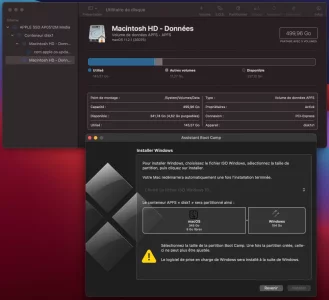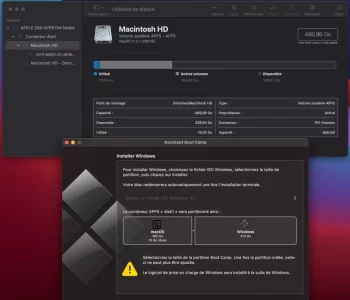diskutil eraseVolume free null disk0s3 ; diskutil ap resizeContainer disk1 0b ; diskutil list internal
Started erase on disk0s3 (BOOTCAMP)
Unmounting disk
Finished erase on disk0
Started APFS operation
Aligning grow delta to 299 963 174 912 bytes and targeting a new physical store size of 499 963 174 912 bytes
Determined the maximum size for the targeted physical store of this APFS Container to be 499 962 146 816 bytes
Resizing APFS Container designated by APFS Container Reference disk1
The specific APFS Physical Store being resized is disk0s2
Verifying storage system
Using live mode
Performing fsck_apfs -n -x -l /dev/disk0s2
Checking the container superblock
Checking the EFI jumpstart record
Checking the space manager
Checking the space manager free queue trees
Checking the object map
Checking volume
Checking the APFS volume superblock
The volume Macintosh HD - Données was formatted by diskmanagementd (1677.60.23) and last modified by apfs_kext (1677.81.1)
Checking the object map
Checking the snapshot metadata tree
Checking the snapshot metadata
Checking the extent ref tree
Checking the fsroot tree
Checking volume
Checking the APFS volume superblock
The volume Preboot was formatted by newfs_apfs (748.77.4) and last modified by apfs_kext (1677.81.1)
Checking the object map
Checking the snapshot metadata tree
Checking the snapshot metadata
Checking the extent ref tree
Checking the fsroot tree
Checking volume
Checking the APFS volume superblock
The volume Recovery was formatted by newfs_apfs (748.77.4) and last modified by apfs_kext (1677.81.1)
Checking the object map
Checking the snapshot metadata tree
Checking the snapshot metadata
Checking the extent ref tree
Checking the fsroot tree
Checking volume
Checking the APFS volume superblock
The volume VM was formatted by apfs_boot_util (1677.50.1) and last modified by apfs_kext (1677.81.1)
Checking the object map
Checking the snapshot metadata tree
Checking the snapshot metadata
Checking the extent ref tree
Checking the fsroot tree
Checking volume
Checking the APFS volume superblock
The volume Macintosh HD - Données was formatted by storagekitd (1677.81.1) and last modified by apfs_kext (1677.81.1)
Checking the object map
Checking the snapshot metadata tree
Checking the snapshot metadata
Checking snapshot 1 of 1 (com.apple.os.update-DCA53726C55B1F85C9B53B535BFFD44ADC546530E0ED9F3DA8BD8BC34C936B3A)
Checking the extent ref tree
Checking the fsroot tree
Checking the file extent tree
Checking volume
Checking the APFS volume superblock
The volume Update was formatted by com.apple.Mobile (1677.50.1) and last modified by apfs_kext (1677.81.1)
Checking the object map
Checking the snapshot metadata tree
Checking the snapshot metadata
Checking the extent ref tree
Checking the fsroot tree
Verifying allocated space
The volume /dev/disk0s2 appears to be OK
Storage system check exit code is 0
Growing APFS Physical Store disk0s2 from 200 000 000 000 to 499 963 174 912 bytes
Modifying partition map
Growing APFS data structures
Finished APFS operation
/dev/disk0 (internal, physical):
#: TYPE NAME SIZE IDENTIFIER
0: GUID_partition_scheme *500.3 GB disk0
1: EFI EFI 314.6 MB disk0s1
2: Apple_APFS Container disk1 500.0 GB disk0s2
/dev/disk1 (synthesized):
#: TYPE NAME SIZE IDENTIFIER
0: APFS Container Scheme - +500.0 GB disk1
Physical Store disk0s2
1: APFS Volume Macintosh HD - Données 145.1 GB disk1s1
2: APFS Volume Preboot 369.4 MB disk1s2
3: APFS Volume Recovery 613.7 MB disk1s3
4: APFS Volume VM 20.5 KB disk1s4
5: APFS Volume Macintosh HD - Données 15.1 GB disk1s5
6: APFS Snapshot com.apple.os.update-... 15.1 GB disk1s5s1
~ diskutil mount disk1s5 ; diskutil rename disk1s5 "Macintosh HD" ; diskutil list internal
Volume Macintosh HD - Données on disk1s5 mounted
Volume on disk1s5 renamed to Macintosh HD
/dev/disk0 (internal, physical):
#: TYPE NAME SIZE IDENTIFIER
0: GUID_partition_scheme *500.3 GB disk0
1: EFI EFI 314.6 MB disk0s1
2: Apple_APFS Container disk1 500.0 GB disk0s2
/dev/disk1 (synthesized):
#: TYPE NAME SIZE IDENTIFIER
0: APFS Container Scheme - +500.0 GB disk1
Physical Store disk0s2
1: APFS Volume Macintosh HD - Données 145.1 GB disk1s1
2: APFS Volume Preboot 369.4 MB disk1s2
3: APFS Volume Recovery 613.7 MB disk1s3
4: APFS Volume VM 20.5 KB disk1s4
5: APFS Volume Macintosh HD 15.1 GB disk1s5
6: APFS Snapshot com.apple.os.update-... 15.1 GB disk1s5s1



